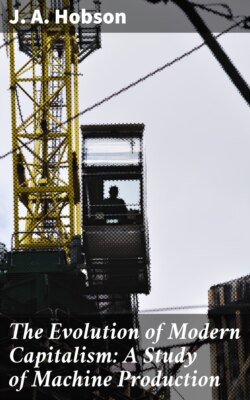Читать книгу The Evolution of Modern Capitalism: A Study of Machine Production - J. A. Hobson - Страница 17
STATISTICS OF WOOL IMPORTED INTO ENGLAND.
Оглавление| lbs. | lbs. | ||
| 1766 | 1,926,000 | 1830 | 32,305,000 |
| 1771 | 1,829,000 | 1840 | 49,436,000 |
| 1780 | 323,000 | 1850 | 74,326,000 |
| 1790 | 2,582,000 | 1860 | 151,218,000 |
| 1800 | 8,609,000 | 1870 | 263,250,000 |
| 1810 | 10,914,000 | 1880 | 463,309,000 |
| 1820 | 9,775,000 | 1892 | 743,046,104 |
In the silk industry the influence of machinery is complicated by several considerations especially affecting this manufacture. Although the ingenuity and enterprise of the Lombes had introduced complex machinery into silk throwing many years before it was successfully applied to any other branch of textile industry, the trade did not grow as might have been expected, and the successive increments of great mechanical invention were slowly and slightly applied to the silk industry. There are special reasons for this, some of them connected with the intrinsic value of the commodity, others with the social regulation of the trade.
The inherent delicacy of many of the processes, the capricious character of the market for the commodities, the expensive production of which renders them a luxury and especially amenable to the shifts of taste and fashion, have preserved for artistic handicraft the production of many of the finer silk fabrics, or have permitted the application of machinery in a far less degree than in the cotton and woollen industries.
Moreover, the heavy duties imposed upon raw and thrown silk, which accompanied the strict prohibition of the importation of manufactured silk goods in 1765, by aggravating the expenses of production and limiting the market at the very epoch of the great mechanical inventions, prevented any notable expansion of consumption of silk goods, and rendered them quite unable to resist the competition of the younger and more enterprising cotton industry, which, after the introduction of colour-printing early in the nineteenth century, was enabled to out-compete silk in many markets.
Even in the coarser silk fabrics where weaving machinery was successfully applied at an early date, the slow progress in "throwing" greatly retarded the expansion of the trade, and after the repeal of the duty on imported silk in 1826 the number of throwing mills was still quite inadequate to keep pace with the demands of the weavers.[76] Subsequent improvements in throwing mills, and the application of the ingenious weaving machinery of Jacquard and later improvers, have given a great expansion to many branches of the trade in the last fifty years.
But the following statistics of the consumption of raw and thrown silk from 1765 to 1844 indicate how slight and irregular was the expansion of the trade in England during the era of the great inventions and the application of the steam-motor, and how disastrously the duties upon raw and thrown silks weighed upon this branch of manufacture.
